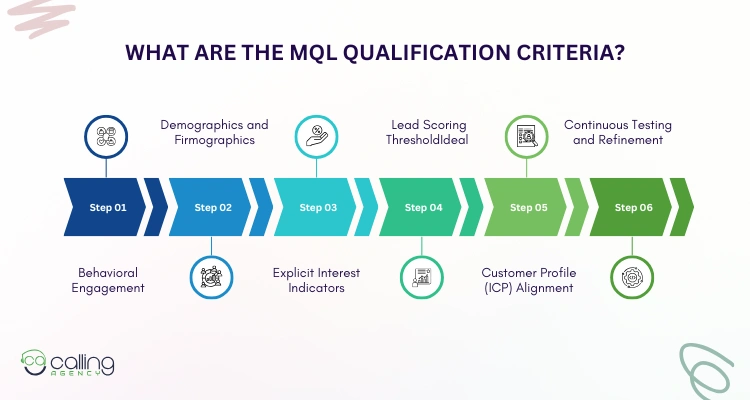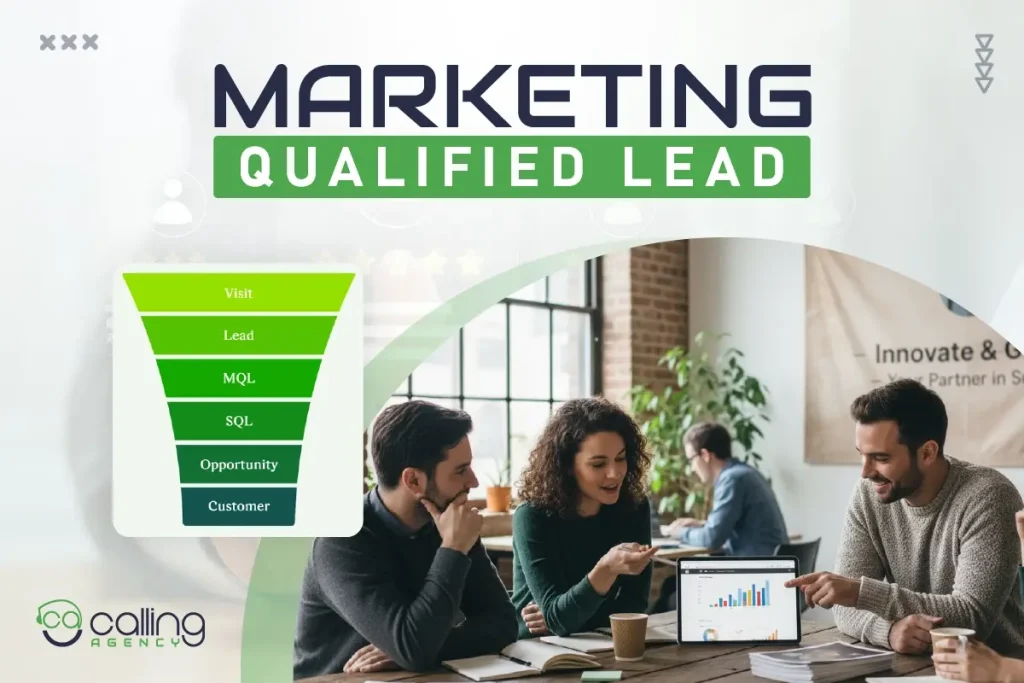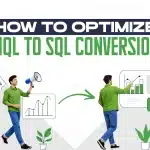Every lead you have may not be sufficiently qualified to put effort and time equally. Then comes conversion, which is more likely a race. So for every business, the ultimate goal is to convert a potential customer into a paid customer. MQL(marketing qualified lead) is a potential lead that can increase the possibility of conversion, rather than just picking a lead and trying. In this article, we will discuss marketing qualified leads, including their definition, criteria, scoring, and best practices.
What Is A Marketing Qualified Lead and Why Does It Matter
A marketing qualified lead is a potential customer who has previously shown interest in your product or service by
- Downloading gated or ungated content, such as an eBook.
- Filling out a demo form.
- Signing up for your newsletter.
- Visiting your site frequently.
- Clicking LinkedIn, Google, or Facebook ads.
- Sending an email through your contact form.
Individuals in research or browsing mode for specific products or services are considered MQL, as they are more likely to convert into paid customers. MQLs (marketing qualified leads) are important because they:
- Increased sales efficiency
- Improved conversion rates
- Better alignment between marketing and sales
- More effective marketing campaigns
- Personalized nurturing
- Higher ROI
A marketing-qualified lead is qualified for marketing, or you can invest in marketing for this lead because it has qualified the initial criteria and has the possibility to be converted as SQL(sales qualified lead), and this phase matters a lot for any company.
What Are the MQL Qualification Criteria?
Effective MQL qualification requires a multi-channel approach that considers different aspects of prospect behavior and characteristics. Let’s take a look at the key criteria that determine MQL status:

Behavioral Engagement
This measures how prospects interact with your brand across multiple touchpoints to keep a footprint of behavioral engagement.
- Website Activity: Page views, time on website, re-visits, and engagement with specific content/blog sections
- Email Engagement: Email open rates, click-through rates, and response to email campaigns
- Content Consumption: Downloads of content, video views, blog engagement, and resource utilization
- Event Participation: Webinar attendance, workshop participation, or conference interactions
- Social Media Interaction: Engagement with social posts, sharing content, or following company accounts
Demographics and Firmographics
Demographic and firmographic data are also equally important for MQl qualification. Find out which of your prospects fit with your business and whom you can target to approach. Let’s see the criteria you can look for to match if they are fit or not.
- Company Size
- Industry Type
- Geographic Location
- Job Title and Seniority
- Technology Stack
Explicit Interest Indicators
Explicit interest of a prospect is mostly significant for MQL qualification because if a lead has a solid interest in your product or service, it becomes easier to convert them. Let’s take a look at explicit interests in more detail below.
- Scheduling a product show or consultations
- Requesting quotes, pricing information, or proposal submissions
- Detailed inquiries about specific products or services
- Direct communication expressing interest in purchasing
- Involvement in formal procurement processes like RFP participation
Lead Scoring Threshold
Lead scoring has been a key qualification criterion for lead qualification methodologies. MQLs are potential customers, so if you try on a lead with a score, then you can easily identify how much you need to put on that, and it will also make the process easier.
- Assigning numerical values to different actions and characteristics
- Giving higher values to high-intent behaviors
- Reducing scores for older activities to maintain relevance
- Deducting points for disqualifying factors
Ideal Customer Profile (ICP) Alignment
An ideal customer profile can be an organization or an individual person who has the authority to make a purchase, and your MQL should be an ICP; otherwise, someone can’t buy your product or service, which does not work in marketing.
- Characteristics shared by your most successful clients
- How well the prospect’s needs align with your solution capabilities
- Positioning within your target market segments
- Long-term value and expansion opportunities
Continuous Testing and Refinement
If your MQL is not high quality and your efforts are going to waste even though you are following all the criteria of qualification, then you need to make a change in your approach to test your process. Optimizing criteria based on performance:
- Conversion analysis to track which MQLs convert to customers
- A/B Testing or experimenting with different qualification thresholds
- Regularly update the criteria, adjusting based on market changes and business evolution
- Monitoring MQL quality and sales acceptance rates
How Account-Based Marketing (ABM) Changes MQL Qualification
Account-Based Marketing fundamentally shifts how organizations approach MQL qualification by focusing on target accounts rather than individual leads. Instead of scoring individual leads, ABM requires evaluating entire accounts based on how well the organization matches your ideal customer profile. ABM recognizes that B2B purchases involve multiple decision-makers and personalized qualification criteria like
- Buying Committee
- Influence Mapping
- Cross-functional Activity
- Consensus Building
- Account-Specific Thresholds
- Industry-Specific Scoring
- Competitive Context
- Strategic Priority
For stakeholder engagement, multiple touchpoints across different roles within the account are significant. Aggregated activities from various accounts create collaborative behavior and contact intent data on organizational-level signals indicating purchase intent.
How Do You Calculate an MQL?
Calculating MQLs involves both quantitative scoring and qualitative assessment. Here is a systematic approach:
Step 1: Establish Baseline Scoring
Create a point system for different activities. See some samples of your competitors or analysis, or you can fix a point according to your point of view, which allows you to understand the importance of their score. Let’s see a sample table.
| High-Intent Actions (50-100 points) | Medium-Intent Actions (25-50 points) | Low-Intent Actions (5-25 points) |
| Demo request: 100 points | Webinar attendance: 40 points | Blog post read: 15 points |
| Pricing inquiry: 80 points | Case study download: 35 points | Newsletter signup: 10 points |
| Contact sales form: 75 points | Product page visits: 30 points | Social media follow: 5 points |
| RFP download: 70 points | Email click-through: 25 points | Webinar Registration: 15 points |
Step 2: Apply Demographic Multipliers
Demographic multiplier is a good identifier of marketing-qualified leads (MQL) for adjusting scores based on fit criteria such as
- Perfect match of ICP: 1.5x multiplier
- Good match of ICP: 1.2x multiplier
- Partial match of ICP: 1.0x multiplier
- Poor match of ICP: 0.7x multiplier
Step 3: Time-Based Calculations
Time-based calculation for MQL is also an effective method of lead qualification. Consider recency of activities:
- Last 7 days: Full points
- 8-30 days: 80% of points
- 31-60 days: 60% of points
- 61-90 days: 40% of points
- Over 90 days: 20% of points
Step 4: Set MQL Threshold
Determine the minimum score for MQL status to segment leads, and help marketers or the sales team close the deal or convert to a sales qualified lead. You can set the MQL threshold like below.
- Review historical data to identify conversion patterns
- Set threshold at the top 20-30% of lead scores
- Balance quality with sales team capacity
- Adjust based on conversion performance
How to Nurture MQLs Into SQLs?
Transforming Marketing Qualified Leads (MQLs) into Sales Qualified Leads (SQLs) requires a strategic approach to nurturing that focuses on the specific needs and concerns of prospects.
Personalized Content Delivery: Provide relevant information based on MQL characteristics such as industry-specific content, role-based messaging, stage-appropriate information, problem solution mapping, etc.
Multi-Channel Engagement: Reach MQLs through their preferred communication channels such as email, social media, retargeting ads, direct outreach, etc, which personalize sales development.
Progressive Profiling: Gradually collect more information to improve qualification, for instance, smart forms, allow prospects to specify their interests and communication preferences, short polls and surveys to better understand needs, monitor engagement patterns to infer preferences, etc
Sales Enablement: Provide sales teams with tools and information for effective follow-ups
How to Build an Effective MQL Lead Scoring Model?
Building a strong lead scoring model requires analysis and continuous optimization. Let’s deep dive into the step-by-step process.
Phase 1: Data Analysis and Foundation
Historical Analysis: You can review past conversions to identify patterns of customer or analyze characteristics of customers vs. non-customers. You can identify common behaviors among high-value customers and determine demographic and firmographic correlations.
Stakeholder Alignment: Involve key teams in model development, like marketing input on engagement behaviors, sales feedback on lead quality indicators, and customer success insights on ideal customer characteristics.
Phase 2: Scoring Framework Development
Let’s see a table below on how you can create an MQL lead scoring framework to segment leads for increased efficiency in conversion.
| Behavioral Scoring | Demographic Scoring | ||||
| Website engagement | Content engagement | Email engagement | Company size | Industry fit | Job role |
| Pricing page visit: 25 points | Ebook download: 15 points | Open: 2 points | 100 to 500 employees: 20 points | Same industry: 25 points | Decision taker: 30 points |
| Product demo page: 30 points | Whitepaper download: 20 points | Click links: 8 points | 500 to 100 employees: 30 points | Adjacent: 15 points | Influencer: 20 points |
| Case studies page: 20 points | Video completion: 10 points | Reply: 15 points | 1000+ employees: 40 points | Non-targeted: 0 points | End user: 10 points |
| Careers page: (-)10 points | Webinar attendance: 40 points | Unsubscribe: (-)50 | >100 employees: 5 points | student/job seeker: (-) 20 points | |
Phase 3: Implementation and Testing
Now you, too, need to set up tools and technologies to simplify work processes, and nowadays, without some tools, qualifying marketing leads will feel difficult, boring, and costly as well. So let’s take a look at how you can set up technology for implementation and testing a marketing-qualified lead.
- Configure scoring in your marketing automation platform
- Integrate with CRM for sales visibility
- Set up automated workflows based on score thresholds
- Create reporting dashboards for monitoring
Phase 4: Optimization and Refinement
At the last stage, optimization and monitoring are very important because if you don’t see how things are going, whether it’s working or not, then how can you make some improvements? So you need to track MQL to SQL conversion rates, monitor sales acceptance rates, analyze customer lifetime value by score range, and assess the time from MQL to closed-won
Proven Marketing Channels That Generate High-quality MQLs
Several marketing channels, like social media, email, and search engines, produce varying MQL quality and quantity. Here are the most effective channels:
- Content marketing
- Paid Ads (PPC)
- Email Marketing
- Search Engine Marketing (SEM)
- Events and Webinars
- Search Engine Optimization (SEO)
- Social Media Marketing
Those are mostly used marketing channels where you will find MQL, but while generating leads, use a proper framework and strategies so your leads come with verification, and reduce lead generation post-work.
How Do You Get Marketing Qualified Leads?
You can generate MQL using several ways, such as inbound marketing, outbound marketing, partnership, and referral. But you need to choose which one fits your goal and business the best. Let’s see them in a brief discussion, and choose according to your needs.
Inbound Marketing
Create a content hub with industry guides, ROI calculators, and interactive tools that address prospect pain points. Optimize for search using long-tail keywords and topic clusters while ensuring fast page loads and mobile responsiveness. Continuously A/B test landing pages, forms, and CTAs to improve conversions from your traffic.
Outbound Marketing
Segment email lists by buyer personas and personalize messages at scale while testing subject lines and send times. Build thought leadership on social media by sharing insights and engaging authentically with prospects’ content. Integrate direct mail with digital campaigns, especially for high-value accounts, using QR codes to bridge offline and online experiences.
Partnerships and Referrals
Develop co-marketing initiatives with complementary businesses through joint webinars, shared content, and referral programs. Turn satisfied customers into advocates through referral incentives, case study development, and user-generated content campaigns.
The key is integrating these channels into a cohesive strategy where each touchpoint reinforces your value proposition and moves prospects toward purchase decisions. Regular analysis and optimization ensure continuous improvement in both lead quality and quantity.
FAQs
What Does MQL Mean in B2B Marketing?
An MQL is a lead that has shown strong interest and matches your target profile, making them worth passing to sales for follow-up. They are not yet fully qualified but are more likely to convert than general leads.
How Do You Define an MQL vs. a Lead?
A lead is any contact who is shared their information. An MQL is a lead that meets your predefined scoring criteria, showing both interest and the right demographic fit for your offering.
Which Actions Count Toward MQL Scoring?
High-value signals include demo or pricing requests, whitepaper downloads, webinar attendance, repeated product page visits, and engaged email interactions.
What’s a Good MQL Volume Per Month?
Small businesses may see 50-200, mid-market 200-500, and enterprise 500+ monthly. Always focus on quality over volume to keep MQL-to-SQL rates healthy.
How Do You Set MQL Thresholds?
Use past conversion data, match sales capacity, and maintain quality benchmarks. Adjust for seasonality or market changes to avoid overloading sales teams.
What Tools Track MQLs Effectively?
Platforms like HubSpot, Marketo, Pardot, Salesforce, and analytics tools like Google Analytics help track MQLs, score them, and measure performance.
How Do MQLs Impact Pipeline Forecasting?
MQLs help estimate sales opportunities, forecast revenue, and plan sales efforts by using historical conversion rates and average deal sizes.
What Causes Low MQL Acceptance Rates?
It’s often due to unclear qualification rules, inaccurate or missing data, poor timing for outreach, or insufficient background provided to sales.
How Do You Audit MQL Quality?
Check conversion metrics, gather direct sales team feedback, ensure data completeness, and analyze which marketing channels deliver the best quality leads.
Should Demo Requests Bypass MQL Status?
Yes, in many cases, they show strong buying intent. However, confirm request details and context before handing it directly to sales.
How Do You Recycle Unqualified MQLs?
Place them in long-term nurture campaigns, retarget with ads, recheck interest every few months, or suggest alternative lower-tier offers.
What Reports Show MQL Performance?
Track generation trends, funnel progression from MQL to customer, source attribution, and distribution of lead scores for quality analysis.
When Should You Revisit or Retire Your MQL Model?
Review if conversion rates drop, your business or market shifts, or you adopt new tools and data that can improve targeting.
Forms vs. Chat: What Converts Better for MQLs?
Forms gather richer data for scoring, while chat boosts instant engagement and qualification. Many companies benefit from combining both.
Which Content Offers Generate Higher-Quality MQLs?
Industry research, ROI calculators, in-depth case studies, product demos, and competitive comparison guides tend to attract high-intent prospects.
Which Fields Are Mandatory for Reliable MQL Reporting?
Essential fields include name, contact info, company name, size, industry, role, lead source, and a record of past interactions.
What is a Healthy MQL-to-SQL Conversion Rate?
Ranges by industry: SaaS 15-25%, professional services 20-30%, manufacturing 10-20%, healthcare 12-22%. A score below 10% suggests loose criteria.
High-Intent vs. Low-Intent Signals: How Should You Weight Them?
Give more points to actions like demo requests and pricing inquiries, moderate points to webinars or product visits, and fewer to casual blog reads.
What Behaviors Commonly Trigger MQL Status?
Frequent engagement, high-value content interactions, and repeat visits over a short period often signal a prospect is ready for sales.





